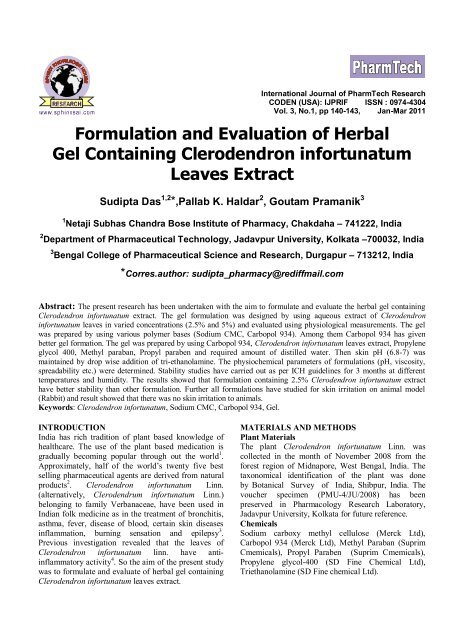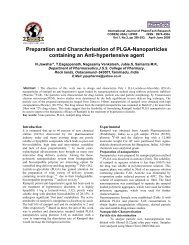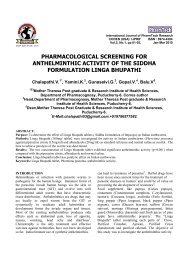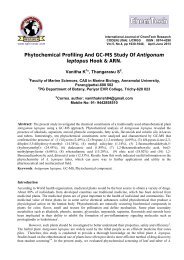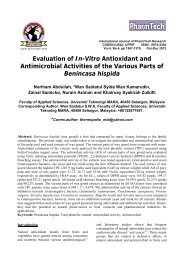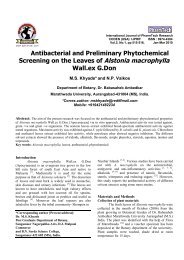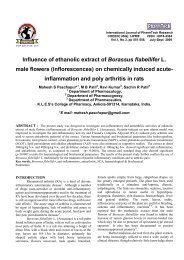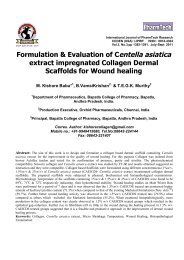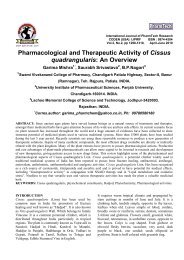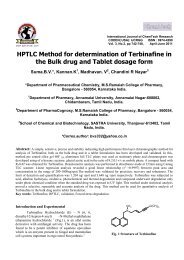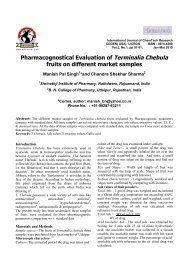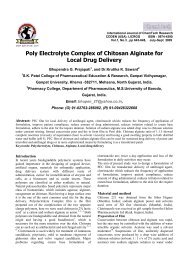Formulation and Evaluation of Herbal Gel Containing Clerodendron ...
Formulation and Evaluation of Herbal Gel Containing Clerodendron ...
Formulation and Evaluation of Herbal Gel Containing Clerodendron ...
Create successful ePaper yourself
Turn your PDF publications into a flip-book with our unique Google optimized e-Paper software.
International Journal <strong>of</strong> PharmTech Research<br />
CODEN (USA): IJPRIF ISSN : 0974-4304<br />
Vol. 3, No.1, pp 140-143, Jan-Mar 2011<br />
<strong>Formulation</strong> <strong>and</strong> <strong>Evaluation</strong> <strong>of</strong> <strong>Herbal</strong><br />
<strong>Gel</strong> <strong>Containing</strong> <strong>Clerodendron</strong> infortunatum<br />
Leaves Extract<br />
Sudipta Das 1,2 *,Pallab K. Haldar 2 , Goutam Pramanik 3<br />
1 Netaji Subhas Ch<strong>and</strong>ra Bose Institute <strong>of</strong> Pharmacy, Chakdaha – 741222, India<br />
2 Department <strong>of</strong> Pharmaceutical Technology, Jadavpur University, Kolkata –700032, India<br />
3 Bengal College <strong>of</strong> Pharmaceutical Science <strong>and</strong> Research, Durgapur – 713212, India<br />
*Corres.author: sudipta_pharmacy@rediffmail.com<br />
Abstract: The present research has been undertaken with the aim to formulate <strong>and</strong> evaluate the herbal gel containing<br />
<strong>Clerodendron</strong> infortunatum extract. The gel formulation was designed by using aqueous extract <strong>of</strong> <strong>Clerodendron</strong><br />
infortunatum leaves in varied concentrations (2.5% <strong>and</strong> 5%) <strong>and</strong> evaluated using physiological measurements. The gel<br />
was prepared by using various polymer bases (Sodium CMC, Carbopol 934). Among them Carbopol 934 has given<br />
better gel formation. The gel was prepared by using Carbopol 934, <strong>Clerodendron</strong> infortunatum leaves extract, Propylene<br />
glycol 400, Methyl paraban, Propyl paraben <strong>and</strong> required amount <strong>of</strong> distilled water. Then skin pH (6.8-7) was<br />
maintained by drop wise addition <strong>of</strong> tri-ethanolamine. The physiochemical parameters <strong>of</strong> formulations (pH, viscosity,<br />
spreadability etc.) were determined. Stability studies have carried out as per ICH guidelines for 3 months at different<br />
temperatures <strong>and</strong> humidity. The results showed that formulation containing 2.5% <strong>Clerodendron</strong> infortunatum extract<br />
have better stability than other formulation. Further all formulations have studied for skin irritation on animal model<br />
(Rabbit) <strong>and</strong> result showed that there was no skin irritation to animals.<br />
Keywords: <strong>Clerodendron</strong> infortunatum, Sodium CMC, Carbopol 934, <strong>Gel</strong>.<br />
INTRODUCTION<br />
India has rich tradition <strong>of</strong> plant based knowledge <strong>of</strong><br />
healthcare. The use <strong>of</strong> the plant based medication is<br />
gradually becoming popular through out the world 1 .<br />
Approximately, half <strong>of</strong> the world’s twenty five best<br />
selling pharmaceutical agents are derived from natural<br />
products 2 . <strong>Clerodendron</strong> infortunatum Linn.<br />
(alternatively, Clerodendrum infortunatum Linn.)<br />
belonging to family Verbanaceae, have been used in<br />
Indian folk medicine as in the treatment <strong>of</strong> bronchitis,<br />
asthma, fever, disease <strong>of</strong> blood, certain skin diseases<br />
inflammation, burning sensation <strong>and</strong> epilepsy 3 .<br />
Previous investigation revealed that the leaves <strong>of</strong><br />
<strong>Clerodendron</strong> infortunatum linn. have antiinflammatory<br />
activity 4 . So the aim <strong>of</strong> the present study<br />
was to formulate <strong>and</strong> evaluate <strong>of</strong> herbal gel containing<br />
<strong>Clerodendron</strong> infortunatum leaves extract.<br />
MATERIALS AND METHODS<br />
Plant Materials<br />
The plant <strong>Clerodendron</strong> infortunatum Linn. was<br />
collected in the month <strong>of</strong> November 2008 from the<br />
forest region <strong>of</strong> Midnapore, West Bengal, India. The<br />
taxonomical identification <strong>of</strong> the plant was done<br />
by Botanical Survey <strong>of</strong> India, Shibpur, India. The<br />
voucher specimen (PMU-4/JU/2008) has been<br />
preserved in Pharmacology Research Laboratory,<br />
Jadavpur University, Kolkata for future reference.<br />
Chemicals<br />
Sodium carboxy methyl cellulose (Merck Ltd),<br />
Carbopol 934 (Merck Ltd), Methyl Paraban (Suprim<br />
Cmemicals), Propyl Paraben (Suprim Cmemicals),<br />
Propylene glycol-400 (SD Fine Chemical Ltd),<br />
Triethanolamine (SD Fine chemical Ltd).
Sudipta Das et al /Int.J. PharmTech Res.2011,3(1) 141<br />
Animal Used<br />
Healthy young adult albino rabbits (1.5-2 kgs) were<br />
maintained in identical laboratory conditions (25º- 30º<br />
C temperature <strong>and</strong> relative humidity <strong>of</strong> 55-65 % with<br />
alternate light <strong>and</strong> darkness 12 hours each) <strong>and</strong> fed<br />
with commercial pellet diet (Hindustan Lever,<br />
Kolkata, India) <strong>and</strong> water ad libitum. All procedures<br />
described were reviewed <strong>and</strong> approved by the<br />
Jadavpur University animal ethical committee (ref no.<br />
367001/C/CPCACA).<br />
Preparation <strong>of</strong> Topical <strong>Gel</strong><br />
Different combinations <strong>of</strong> <strong>Clerodendron</strong> infortunatum<br />
leaves extract (2.5%, 5%) were tried with different<br />
types <strong>of</strong> polymers (Sodium CMC, Carbopol 934) using<br />
various formulae. The following few combination with<br />
Carbopol 934 resulted in the best gel formulation,<br />
which was smooth <strong>and</strong> stable. Control sample also was<br />
prepared for testing <strong>of</strong> animal to check the activity <strong>of</strong><br />
control ingredients.<br />
Method for Preparation <strong>of</strong> <strong>Gel</strong> <strong>Containing</strong> Extract<br />
1 g <strong>of</strong> Carbopol 934 was dispersed in 50 ml <strong>of</strong> distilled<br />
water with continuous stirring.<br />
5 ml <strong>of</strong> distilled water was taken <strong>and</strong> required quantity<br />
<strong>of</strong> methyl paraben <strong>and</strong> propyl paraben were dissolved<br />
by heating on water bath. Cool the solution, then to<br />
that added Propylene glycol 400. Further required<br />
quantity <strong>of</strong> C. infortunatum leaves extract was mixed<br />
to the above mixture <strong>and</strong> volume made up to 100 ml<br />
by adding remaining distilled water. Finally full mixed<br />
ingredients were mixed properly to the Carbopol 934<br />
gel with continuous stirring <strong>and</strong> triethanolamine was<br />
added drop wise to the formulation for adjustment <strong>of</strong><br />
required skin pH (6.8-7) <strong>and</strong> to obtain the gel at<br />
required consistency. The same method was followed<br />
for preparation <strong>of</strong> control sample without adding any<br />
C. infortunatum leaves extract.<br />
<strong>Formulation</strong><br />
The method describes above <strong>and</strong> the formulae were<br />
tabulated in Table 1. Along with control sample gel<br />
were prepared with addition <strong>of</strong> 2.5g, 5g <strong>of</strong> C.<br />
infortunatum leaves extract to prepared 2.5% <strong>and</strong> 5%<br />
C. infortunatum gel respectively.<br />
EVALUATION OF TOPICAL GEL<br />
FORMULATION<br />
A. Physical <strong>Evaluation</strong><br />
Physical parameters such as color <strong>and</strong> appearance were<br />
checked.<br />
B. Measurement <strong>of</strong> pH<br />
pH <strong>of</strong> the gel was measured by using pH meter.<br />
C. Spreadibility<br />
Spreadibility was determined by the apparatus which<br />
consists <strong>of</strong> a wooden block, which was provided by a<br />
pulley at one end 5 . By this method spreadibility was<br />
measured on the basis <strong>of</strong> slip <strong>and</strong> drag characteristics<br />
<strong>of</strong> gels. An excess <strong>of</strong> gel (about 2g) under study was<br />
placed on this ground slide. The gel was then<br />
s<strong>and</strong>wiched between this slide <strong>and</strong> another glass slide<br />
having the dimension <strong>of</strong> fixed ground slide <strong>and</strong><br />
provided with the hook. A. 1 kg weighted was placed<br />
on the top <strong>of</strong> the two slides for 5 minutes to expel air<br />
<strong>and</strong> to provide a uniform film <strong>of</strong> the gel between the<br />
slides. Excess <strong>of</strong> the gel was scrapped <strong>of</strong>f from the<br />
edges. The top plate was then subjected to pull <strong>of</strong> 80<br />
gms. With the help <strong>of</strong> string attached to the hook <strong>and</strong><br />
the time (in seconds) required by the top slide to cover<br />
a distance <strong>of</strong> 7.5 cm be noted. A shorter interval<br />
indicates better spreadibility. Spreadibility was<br />
calculated using the following formula:<br />
S = M × L / T<br />
Where, S = Spreadibility, M = Weight in the pan (tied<br />
to the upper slide), L = Length moved by the glass<br />
slide <strong>and</strong> T = Time (in sec.) taken to separate the slide<br />
completely each other.<br />
D. Viscosity<br />
Viscosity <strong>of</strong> gel was measured by using Brookfield<br />
viscometer with spindle.<br />
E. Stability Study<br />
The stability study was performed as per ICH<br />
guidelines 6 . The formulated gel were filled in the<br />
collapsible tubes <strong>and</strong> stored at different temperatures<br />
<strong>and</strong> humidity conditions, viz.<br />
25 0 C ± 2 0 C/ 60% ± 5% RH, 30 0 C ± 2 0 C/ 65% ± 5%<br />
RH, 40 0 C ± 2 0 C/ 75% ± 5% RH for a period <strong>of</strong> three<br />
months <strong>and</strong> studied for appearance, pH, viscosity <strong>and</strong><br />
spreadibility 7 .<br />
APPLICATION OF HERBAL GEL AND SKIN<br />
IRRITATION STUDY<br />
0.5 gms <strong>of</strong> the herbal gel was used as the test<br />
substance was applied to an area <strong>of</strong> approximately 6<br />
cm 2 <strong>of</strong> skin <strong>and</strong> covered with a gauze patch. The patch<br />
was loosely held in contact with the skin by means <strong>of</strong> a<br />
semi-occlusive dressing for the duration <strong>of</strong> 1 hour <strong>and</strong><br />
gauze was removed. At the end <strong>of</strong> the exposure period,<br />
i.e, 1 hour, residual test substance was removed,<br />
without altering the existing response or integrity <strong>of</strong><br />
the epidermis. Observations have recorded after<br />
removal <strong>of</strong> the patch. Control animals were prepared in<br />
the same manner <strong>and</strong> 0.5 gms <strong>of</strong> the gel base i.e., gel<br />
formulated using all ingredients except the herbal<br />
mixture was applied to the control animals <strong>and</strong><br />
observations were made as similar to the test animals 8 .
Sudipta Das et al /Int.J. PharmTech Res.2011,3(1) 142<br />
The gel was applied to the skin once a day for 7 days<br />
<strong>and</strong> observed for any sensivity <strong>and</strong> the reaction if any<br />
was graded as 9 :<br />
A – No reaction, B – Slight patchy erythema, C –<br />
Slight but confluent or moderate but patchy erythema,<br />
D – Moderate erythema, E – Severe erythema with or<br />
without edema.<br />
Table 1: Different formulations prepared with this ingredients along with quantity.<br />
<strong>Formulation</strong>s Ingredients Quantity<br />
Control<br />
Carbopol 934 1 gm<br />
Methyl Paraben (0.5%) 0.2 ml<br />
Propyl Paraben (0.2%) 0.1 ml<br />
Propylene glycol 400 (5%) 5 ml<br />
Triethanolamine (q.s) 1.2 ml<br />
Distilled water Upto 100 ml<br />
Table 2: Physical evaluation <strong>of</strong> all formulations at the time <strong>of</strong> gel formulation (Initial month).<br />
<strong>Formulation</strong> Color Appearance Spreadibility (gm.cm/sec) P H<br />
Control White Clear <strong>and</strong> Transparent 15.72 7.0<br />
F- I (2.5%) Greenish Clear <strong>and</strong> Translucent 21.65 7.0<br />
F – II (5%) Greenish Clear <strong>and</strong> Translucent 19.78 7.0<br />
Table 3: 25 0 C ± 2 0 C/ 60% ± 5% RH at 3 rd months.<br />
<strong>Formulation</strong> Appearance Spreadibility (gm.cm/sec) P H<br />
Control Clear <strong>and</strong> Transparent 15.23 6.98<br />
F- I (2.5%) Clear <strong>and</strong> Translucent 20.38 7.0<br />
F – II (5%) Clear <strong>and</strong> Translucent 18.67 6.92<br />
Table 4: 30 0 C ± 2 0 C/ 65% ± 5% RH at 3 rd months.<br />
<strong>Formulation</strong> Appearance Spreadibility (gm.cm/sec) P H<br />
Control Clear <strong>and</strong> Transparent 15.66 6.97<br />
F- I (2.5%) Clear <strong>and</strong> Translucent 21.22 6.98<br />
F – II (5%) Clear <strong>and</strong> Translucent 18.43 6.93<br />
Table 5: 40 0 C ± 2 0 C/ 75% ± 5% RH at 3 rd months.<br />
<strong>Formulation</strong> Appearance Spreadibility (gm.cm/sec) P H<br />
Control Clear <strong>and</strong> Transparent 14.87 6.95<br />
F- I (2.5%) Clear <strong>and</strong> Translucent 20.15 6.97<br />
F – II (5%) Clear <strong>and</strong> Translucent 17.46 6.91<br />
Table 6: Skin irritation study results.<br />
Treatment Day 1 Day 2 Day 3 Day 4 Day 5 Day 6 Day 7<br />
Control A A A A A A A<br />
F-I (2.5%) A A A A A A A<br />
F – II (5%) A A A A A A A
Sudipta Das et al /Int.J. PharmTech Res.2011,3(1) 143<br />
RESULTS AND DISCUSSIONS<br />
The herbal gel was greenish in color <strong>and</strong> translucent in<br />
appearance <strong>and</strong> gave smooth feel on application which<br />
was maintained after tested stability study (Table 2, 3,<br />
4 &5). P H also maintained through out the study which<br />
was found 6.91 to 7.0. Spreadibility was also measured<br />
<strong>and</strong> found to be less variation with the initially<br />
prepared gel after performs the stability study (Table 2,<br />
3, 4 &5). The initial viscosities <strong>of</strong> developed gels were<br />
measured using Brookfield viscometer with spindle.<br />
Further stability test for three months has been carried<br />
out <strong>and</strong> results revealed gel containing 2.5% C.<br />
infortunatum showed better stability than 5%. Initial<br />
viscosity for gel containing 2.5% <strong>and</strong> 5% C.<br />
infortunatum extract were 27390 cps <strong>and</strong> 29640 cps<br />
respectively <strong>and</strong> after stability study there were not<br />
much variation at different temperature <strong>and</strong> humidity.<br />
The gel was non-irritant upon application on to the<br />
skin (Table 6). The control <strong>and</strong> experimental rabbits<br />
showed no signs <strong>of</strong> tremor, convulsion <strong>and</strong> reflex<br />
abnormalities. The food intake per day had also found<br />
REFERENCES<br />
1. Wohlmuth H, Oliver C <strong>and</strong> Nathan P. J, A<br />
review <strong>of</strong> the status <strong>of</strong> western medicine in<br />
Australia, J. Herb. Pharmacother, 2002, 2, 33-<br />
46.<br />
2. Abelson P. H, Medicine from plants, Science,<br />
1990, 247, 513-519.<br />
3. Sreevastava N, <strong>Clerodendron</strong> <strong>and</strong> healthcare,<br />
J. Med. And Aro. Plant Sci. <strong>and</strong> Biotech,<br />
2007, 1, 142-150.<br />
4. Das S, Haldar P. K, Pramanik G <strong>and</strong> Suresh<br />
R.B, <strong>Evaluation</strong> <strong>of</strong> anti-inflammatory activity<br />
<strong>of</strong> <strong>Clerodendron</strong> infortunatum linn. extract in<br />
rats, Global J. Pharmacology, 2010, 4(1), 48-<br />
50.<br />
5. Kumar L, Verma R, In vitro evaluation <strong>of</strong><br />
topical gel prepared using natural polymer, Int.<br />
J Drug Delivery, 2010, 2, 58-63.<br />
*****<br />
normal during 7 days repeated dose dermal toxicity<br />
evaluation.<br />
CONCLUSION<br />
Natural remedies are more acceptable in the belief that<br />
they are safer with fewer side effects than the synthetic<br />
ones. <strong>Herbal</strong> formulations have growing dem<strong>and</strong> in the<br />
world market. It is a very good attempt has made to<br />
establish the herbal gel containing C. infortunatum<br />
leaves extract at various concentrations (2.5% <strong>and</strong><br />
5%). The studies revealed that the developed single<br />
herbal formulation consisting 2.5% C. infortunatum<br />
extract comparatively better than later other<br />
formulation but all the formulations were non irritant<br />
<strong>and</strong> did not show any skin toxicity when applied daily<br />
for 7 days in rabbits.<br />
ACKNOWLEDGEMENT<br />
The financial assistance <strong>of</strong> Department <strong>of</strong><br />
Pharmaceutical Technology, Jadavpur University,<br />
kolkata, India is gratefully acknowledged.<br />
6. ICH guidelines, Stability testing <strong>of</strong> new drug<br />
substances <strong>and</strong> products, 27 th October, 1993.<br />
7. Carl AB, Edward RA, David EB, Tietz NW,<br />
Text book <strong>of</strong> clinical chemistry <strong>and</strong> molecular<br />
diagnostics, 4 th rev. ed., W.B Saunders<br />
Philadelphia, 2001.<br />
8. Das K, Dang R, Machale UM, Fatepuri S,<br />
<strong>Formulation</strong> <strong>and</strong> evaluation <strong>of</strong> herbal gel<br />
containing stevia leaves extract, The Pharma<br />
Review, 2010, 8(44), 112-118.<br />
9. Prakash RP, Rao R. NG, Soujanya C,<br />
<strong>Formulation</strong>, evaluation <strong>and</strong> anti-inflammatory<br />
activity <strong>of</strong> topical etoricoxib gel, Asian J.<br />
pharmaceutical <strong>and</strong> clinical research, 2010,<br />
3(2), 126-129.


